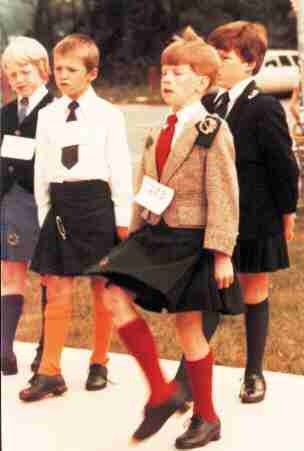
Figure 1.--These beginning dancers wear many colored kneesocks, but muted kilts. Several are wearing their standard school costume.


Figure 1.--These beginning dancers wear many colored kneesocks, but muted kilts. Several are wearing their standard school costume. |
Dancing schools and individual dancers have provided some helpful information for the parents any younger dancers to help prepare them for their first feis.
Most Irish dancing schools provide elaborate details to their dancers on costuning. The schools vary greatly, however, in their requirements for their students' first feis. Some teachers require that their students be properly
outfitted right from the beginning. Some require that their younger dancers where a kind of identical school costume. Others allow first-timers, especially
the younger boys, to forego some of the costuming requirements until they
"get their feet wet." They are sometimes allowed considerable flexibility in their dancing costumes.
The following list provides a basic idea about the costumes
worn so that the younger children know what to expect. Many dancers have attended feises as younger children, especially dancers with olders brothers and sisters doing Irish dancing. Other dancers are entirely new and have no idea what to expect.
The following is a good basic list of the costumes worn. It gives a good idea of the costuming.
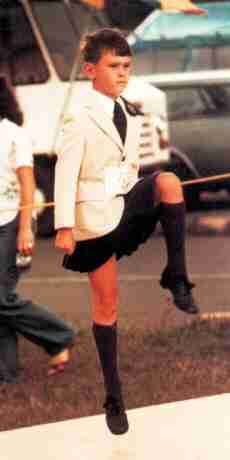
Figure 2.--Some of the beginning dancers are capable of quite fancy footwork. This boy wears his school costume. |
The typical boys and girls costumes consists of:
The following elements make up the girls' costumes:
- dress bearing the school design (Individually patterned ["solo"]
dresses usually mark advancement)
- shawl or cape bearing the school design
- dance briefs (usually the color of the lining of the skirt)
- brooches for pinning the cape or shawl
- headband in the school color or design
- white "poodle" socks
- standard soft (girl's) or hard Irish dance shoes (beginners may have
only soft shoe dances)
The following elements make up the boys' daning costume:
- shirt and tie
- long pants OR kilt and knee socks
- blazer or jacket
- some boys' costumes include a narrow scarf or shawl (if there is a
shawl, brooches may be required)
- standard soft (boy's) or hard Irish dance shoes (beginners may have
only soft shoe dances)
Each Irish dance school school has several different costumes. There
is one or more costumes for
kids, depending on their level; many schools have one costume for beginners and
another for dancers at the intermediate level. Junior and senior dancers (teens and
adults who have reached a high level in competition) have different dresses. Adult
dancers (adults who have not danced in at least five years) have yet another
costume, which is more often a skirt and blouse or jacket than a dress.
When dancers reach a certain level in competition, they may receive a solo dress.
The dress, usually made in Ireland or England, is velvet with satin linings and lots
of colorful embroidery. The solo dress is a sign that a dancer has achieved a
high-level of skill in Irish step dancing. It is worn during individual (solo)
competitions; for team (figure dancing) competitions, the dancer wears the standard
school costume for their level.
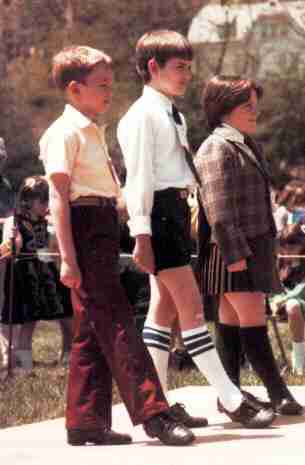
Figure 3.--Some of the younger boys dance in short pants rather than longs. The boys dancing in shorts, always wear kneesocks like the boys dancing in kilts. |
Where do you get all these items? At many schools, new dancers often borrow outgrown costumes from other dancers or the teacher. When it is time to purchase your own, you might see who has outgrown costumes and
shoes for sale.
New shoes, "poodle" socks, and brooches may be available for purchase at the feis. In our area, Irish importers have booths with dance goods for sale in
addition to gift and food items. If you don't want to wait until the feis, you
might look for Irish import shops in your area. Around here, girls' soft shoes
run around $35.00, and hard shoes sell in the neighborhood of $100.00.
The hair of the dancers is given considerable attention. Of course it is the
girl's hair that gets the most attention, but mothers can also often be seen brushing or combing their son's hair.
According to standard, girls' hair is worn in ringlets. The top section of hair is
tied in a ponytail, and curled into ringlets to match the rest. If bangs are worn,
they too are curled. There is a known association between ringlets and
baldness - that is, trying to force their daughters' hair into ringlets has caused
many a parent to pull out their own hair in frustration. At the O'Connor school, we recommend either of the following methods to achieve those perfect curls:
Method I: Prepare your child's hair at least 24 hours before it needs to be ready. Some of us have made arrangements for our daughters to
attend school in curlers the day before a feis, allowing extra curler
time. Stubborn hair prepared on Thursday night has come out just
right on Saturday morning.
Wash your child's hair and dry it thoroughly. Avoid using
conditioner. (If there is time for hair to dry completely while in
curlers, it can be effective to roll it while wet. Be advised,
however, that the slightest dampness will cause the curls to droop almost immediately.)
Gather the top section of hair into a pony tail (sort of a top knot). Separate hair (including pony tail and bangs) into small sections. Saturate each section with spray gel, wrap bottom of section in end paper, and wind section vertically around a small sponge roller.
You may want to cover the curlers with a hair net once the spray gel is dry. he morning of the feis, remove the rollers gently, winding each ringlet around your finger if necessary to retain the curl. Do not
brush hair (except bangs). Spray hair all over with gel or hair
spray. Cover hair with a net until dance time (make sure the spray
is dry first).
Whatever you do, don't use velcro rollers! (Contributed by Keara
Osborne).
Method II: At least 24 hours before the hair needs to be ready, take your
daughter, your bag of curlers, and your favorite spray gel to the
beauty parlor of your choice; plop her into the chair, tell the stylist
what to do, and go shopping. (Contributed by Keara Osborne's
mother.)
Ringlet curls are of course just a matter for the girls. Boys dancing
in the 1970s and 1980s sometimes had long hair, but this was unusual as Irish American families
were often conservativevand the dancing schools discouraged long hair.
Of course ringlet curls werevnot always reserve strictly for girls.
American boys sometimes wore
ringlets during the Fauntleroy craze of the late 19th Century and early 20th Century.
Boys' hair
Dancers should be present and ready to dance one-half hour before scheduled start
time. (This means dressed, haired, and numbered.) Here's what you do:
Upon arrival, check in with your teacher. If your child is dancing in solo
categories, your teacher (or the parent to whom your teacher has designated
this chore) will give you a card with a large number printed on it. This is the
dancer's number, which your child wears pinned to the front of the costume
at the waist.
Next, you need to find out when and where your child will dance. Events are numbered; your teacher will give you a list of events in which your child is entered. (Check the back of the card with the dancer's number - often the list is there.) Consult the schedule to find out (a) what time and (b) on which stage each event takes place. (Schedules are often printed in the feis program and/or displayed in various places about the feis.)
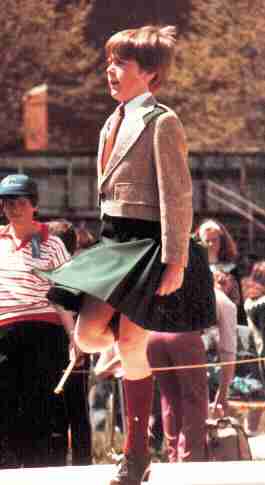
Figure 4.--Some schools have established costumes for the novice dancers. Green kilts and orange kneesocks were a common choice. |
Have a look at each stage on which your child will be dancing, and note the area next to the stage where the dancers line up. There will be a feis staff
member there, checking in the dancers for each event.
Children should check in for each event as soon as the dancers in the preceding event walk out on stage. Direct your child to the person checking in the dancers.
Once your child has checked in, take off. Be brave. There's nothing more you
can do, so pick a spot, watch, and enjoy.
NOTE: Events are likely to be scheduled out of numerical order, so you will need
to keep an eye on the day's progress to make sure your dancer is at the right stage
at the right time. Events are grouped by age and skill level, and brand new dancers
may dance their solo events one after the other on the same stage, but there is no
guarantee this will be the case . (This does not include special events, such as a
"first feis special," which may take place later in the day on a different stage.)
If your child is dancing in figure categories (group dances with one or more partners), remove the solo number for the figure dances. New numbers are worn for the figure dances - one number per team per event, worn by only one dancer. For instance, if your son has a two-hand, he and his partner will remove their solo numbers, and your teacher will give one of them a new number to wear. If your son has a three-hand next, the two-ha nd number comes off, and a three-hand number will be given to one of the three to wear. T o sum up: your dancer wears the same number for all solo events of the day, including specials, but a different number for each figure event (which may act ually be worn by someone else on the team).
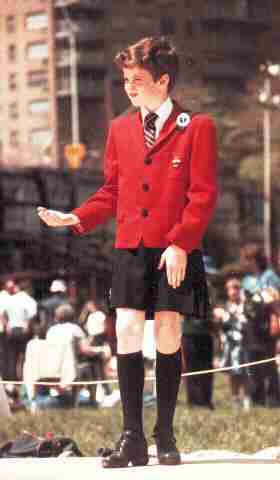
Figure 5.--This dancer is asking the acordianist to slow the music slightly. Note the striped ties, most dancers wear solid colored ties. |
Here's a tidbit that may not pertain to your first feis, but will help you understand
what's going on around you: Dancers typically progress to the next skill level one category at a time, and
sometimes have to zip back and forth from stage to stage. For instance, Beginner I
(skill level) Under 9 (age as of Jan. 1) may be scheduled on Stage A, and Beginner
II Under 9 may be scheduled on Stage B at the same time. If your 8-year-old
daughter has progressed to Beginner II in her Light Jig, she may have to do her
Reel on Stage A, pop over to Stage B to do her Light Jig, then pop back to Stage A
for the rest of her dances. The more they progress, the greater the potential for
such scattered schedules, and routing them through the day can get somewhat
harrowing. On the other hand, they have an annoying habit of growing older while
all this progress is taking place, and all too soon they become quite capable of
taking over their own schedules. So take heart, it won't be long before you walk
them in the door and they abandon you entir ely (except for money requests).
Awards are distributed differently from feis to feis. In our area, the most common
practice is to halt the dancing periodically for award presentations, during which the
results are announced and dancers are called to the stage to receive their medals or
trophies. A less frequent practice here (although common elsewhere) entails posting
the results of the non-championship categories and providing an award distribution
center. For on-stage presentations, dancers should be in full costume and wearing
their numbers. When figure awards are given, all team members go on stage. The
announcer may call only th e e vent number, the rankings, and the competit or
numbers. Dancers must listen for their numbers and rank (1st, 2nd, 3rd. etc.), and
go immediately on the stage if they are called.

Figure 6.--. |
Perhaps the most important information to give you pertains to the timing of your
day at the feis. No amount of advanced planning can prevent a ubiquitous feature
of feiseanna, namely, delays. We hope that by explaining a few of the reasons for
what appears to be the slow pace of a feis, we can help you plan your time and
avoid frustration.
First, the amount of time it will take to complete a group of events can only be
estimated. Estimates are based on the number of entrants, but it is often the case
that schedules must be determined before all the entries are submitted. Thus, you
may have knocked yourself out to get your child there, ready to dance at nine
o'clock in the morning, only to find that the preceding events have not yet begun.
The complexity of feis planning and the large number of involved parties make
these types of delays unavoidable. (On the other hand, as dancers are required to
be ready one half hour before their first event is scheduled, it has happened that
events began before the scheduled time, although delays are much more common.)
Second, as human beings, and not electric trains, are the subjects here, dance
schedules cannot be executed as smoothly as train tables. Sometimes,
circumstances will require that an event be restarted. Sometimes, an event needs to
be reconfigured into two separate events to accommodate all the dancers.
Sometimes, a musician or adjudicator simply HAS to leave the room for a minute
(it takes an awful lot of coffee to stay focused throughout the day).
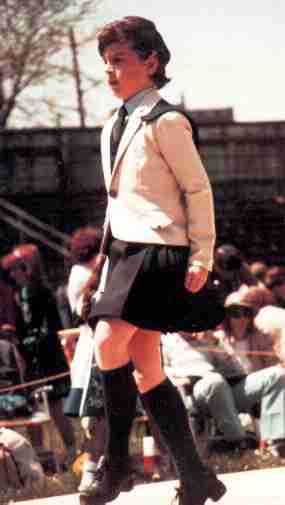
Figure 7.--The standard convention for boys' costumes is to match the kneesocks with either the jacket or kilt. |
Third, it is outright impossible to schedule the events such that all dancers get to
dance all their categories at once and be finished. Similar skill levels and age groups
are grouped as closely as possible, but because dancers compete in different skill
levels according to their progress, there is no way to schedule the events such that
all ages and levels are covered at the same time.
Fourth, figure teams combine a few ages, so figure scheduling has to consider solo
scheduling for multiple age groups. Moreover, as figure events need to be held
together, a broader range of ages and skill levels must be accommodated.
Fifth, on-stage award ceremonies tend to slow the whole process. It is truly a
delight to see your child walk across the stage to receive that medal and to hear the
applause and shouts of support from your child's classmates. There is a price to pay
for this public acclaim, however. These award presentations easily approach chaos,
especially for the younger, less experienced groups. A mysterious daze seems to
overcome the little ones at awards time, and many go downright catatonic. Come to
think of it, even the more experienced dancers often exhibit the same symptoms.
Here's what is supposed to happen: the announcer identifies the event, then calls out the number of the
dancer in third place, second, then first. (Large competitions may award
as many as fifth place winners.) Feis staff members await the winners
on stage to present their medals. Dancers whose numbers are called take
the stage immediately and tell the feis staff which place medal they get.
The announcer quickly moves on to the next event.
Here's what really happens: Dancers miss their number when it is called. After considerable
searching by the feis staff on stage, and prompting and shooing by parents and teachers, they drift up to the stage with a "What am I being sent up here for?" look on their faces. The feis staff ask the dancers
which medal they won, and get confused shrugs in response. The announcer, who has moved on to the next event, has to stop, go back through the papers, and recall that event. Then the process repeats itself
when the dancers, standing on stage and admiring their medals, miss hearing their numbers called in the results of the next event.
The whole routine is really comical in abstraction, however it does considerably slow the day. New parents, you might want to give a hand here. Listen for your
child's number when the relevant results are announced, and if it is called, tell your child WHICH PLACE he or she won as you give that guiding shove toward the
stage.
The bottom line of this topic is that there will often be large gaps of time when your
child won't be dancing. This simply can't be helped.
The girls get hot in those dresses between dances. Some girls wear body suits underneath and bring shorts so they can hop out of the costumes during gaps in the dancing.
It is a good idea to have a large, button-up shirt available to cover the girls' dresses for meals on the fly.
Food is generally available for purchase at the feis, however a few snacks and
a water bottle can be awfully handy (particularly when your dancer, who has
refused to eat all day, suddenly cries "Starvation!" as she should be lining up
for her next event). It is not a good idea to plan to run out for a
meal during the day, as the schedule may change or your teacher may want
to squeeze in some practice.
Bring things for your dancers and their siblings to do between dances. Yes,
they may never touch them, but at least you'll have an answer when they
wail, "I'm bored." Books, cards, and one-piece games and crafts seem to be
the favorites. Avoid noisy items, as noise is always a problem.
Bring things for yourself to do, or perhaps more to the point, if you're
dragging along a somewhat reluctant spouse, bring things for him or her to do.
It has been our experience that the reluctant spouses do the most whining.
This is a great opportunity to whip out that book, magazine, or crossword
puzzle they won't let you throw out because they keep meaning to get to it
when time permits.
Lastly, bring a still camera, but DO NOT BRING a video camera. Videotaping of the dancing is STRICTLY PROHIBITED - NO EXCEPTIONS! Okay, you probably could videotape the awards, although that is often easier said than done, considering the crowds. However, if you
even walk around with a video camera in you hand during the dancing, a number of feis staff will swoop down and remind you that YOU MAY NOT VIDEOTAPE THE DANCING! This is a rule from on high (Dublin, that is). It is strictly enforced, to protect the propriety of the choreography.
Whew! This is quite a list. We hope we haven't intimidated you with all this. There
is a lot to learn about feis life, and these are the things our parents have often said
they wished they knew beforehand. Some of us look on a feis as a mini-vaction,
happy to spend the day listening to the wonderful music, admiring the beautiful
costumes, enjoying the various displays of dancing talent, and delighting in our
children's participation. Okay, okay, some of us can't wait to get at the Irish import
booths. Our hope is that by sharing these tips, you will come to enjoy a day at the
feis as much as we.
Really, the most important thing to remember is to ask a fellow parent when you
have a question. Feis parents are a stunningly friendly and helpful lot, and anyone
will be happy to help you out.
Failte, new parents and dancers.
Navigate the Historic Boys' Clothing Web Site:
[Introduction]
[Chronologies]
[Style Index]
[Biographies]
[Activities]
[Countries]
[Bibliographies]
[Contributions]
[Frequently Asked Questions]
[Boys' Clothing Home]
Navigate the Historic Boys' Clothing Web chronological pages:
[The 1880s]
[The 1890s]
[The 1900s]
[The 1910s]
[The 1920s]
[The 1930s]
[The 1940s]
[The 1950s]
Navigate the Historic Boys' Clothing Web dance pages:
[Return to the main Irish step dancing page]
[Main dance page]
[Ballet]
[Highland]
[Ballroom]
[Native American]
[Tap]
Navigate the Boys' Historical Clothing kilt pages:
[Main kilt page]
[Kilt suits]
[Scottish kilts]
[Scottish boys clothing]
[Scottish school uniform]
[Highland dance]
[Irish kilts]
[Irish boys clothing]
[Main Irish step dancing page]
[Greek kilts]
